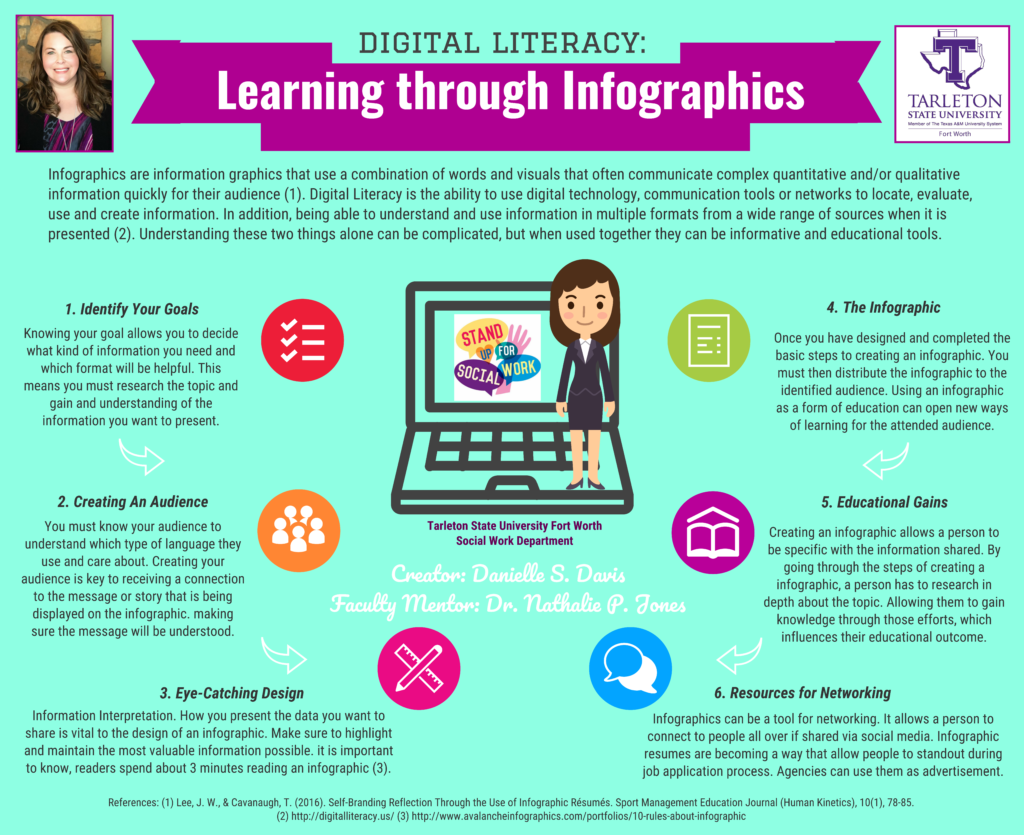Creating an Infographic in a Social Work Course: A Student’s Perspective from Danielle Davis
Last year, Dr. Nathalie P. Jones, from the Department of Social Work at Tarleton State University, wrote a blog post about her experience with a tech-meditated assignment for her social work courses – creating an infographic. She frequently uses technology in her classrooms to help students improve their digital literacy skills, and specifically uses infographics as tools for digital storytelling. As a follow-up to Dr. Jones’ post, I asked one her students, Danielle Davis, to share her thoughts on the assignment, what it was like to create an infographic, and how the knowledge and skills from the assignment might be incorporated in her future role as a social worker. Here are Danielle’s responses to my questions:
What were your initial reaction to the infographic assignment?
I was very hesitant when Dr. Jones initially discussed the infographic assignment in our service learning course. It was the second week of my social work undergraduate program, and I remember wondering if anyone else was as confused as I felt in that moment. I was worried about not being able to complete the assignment according to the grading rubric. I had never created an infographic before, however, I was willing to try. The infographic assignment allowed me the opportunity to be creative and share the information learned about working with vulnerable populations. Being able to use my creative side in an assignment was very appealing.
How did your reaction change over the semester?
Over the semester my reaction to the assignment changed entirely. As we worked on the various steps in the assignment, I started to gain a better understanding about the importance of an infographic and how they can be used. The infographic assignment ended up being my favorite assignment. I enjoyed being able to take a social work issue that mattered, build the infographic that reflected real statistics, and then share the information in Twitter to a large, public audience. I was amazed that people from all over the nation could come together in one place on social media and share information about social work by using infographics.
What steps did you take to learn about how to create an infographic and how to present ideas visually?
One of the first steps was viewing different infographics online and watching videos about how to create an infographic on YouTube. This was so useful to help me visualize the process of creating my infographic. The next step was having to create a clear idea of what information to include the infographic as well as think about the design – how the infographic should look. First, I really had to sort through the material in my head to present it in an easy to understand format, and then I had to decide how to visually represent the concepts which I felt were important and appropriate for the topic of the infographic. Creating a draft infographics helped me improve the overall look of my assignment and also helped me retain the information I was studying.
How do you plan to use skills from this assignment in professional practice? Or how have you already?
During my undergraduate program, I was given an opportunity to present at Tarleton State University’s College of Health Sciences and Human Services Research & Scholarship Showcase. I shared a poster presentation about infographics (see below). I created my poster by using an infographic design, and discussed how you can learn through infographics, and the steps to creating an infographic. Understanding the purpose and process of creating an infographic opened my eyes to the ability to use them in my professional practice as a social worker.
I now work with the geriatric population in a skilled nursing facility. I help bridge my clients with community referrals such as home health services, hospice and or caregivers. Many of these different companies have pamphlets to give my clients. These pamphlets are nothing more than a paper infographic. They have bulleted information and statistics to reach the targeted audience, allowing that audience to make an informed decision.

Danielle’s poster from the Tarleton State University’s College of Health Sciences and Human Services Research & Scholarship Showcase
Would you recommend this assignment to other social worker educators for their classes? Why?
I would certainly recommend this assignment to social work educators. Using design to visually represent information has been around a long time. Having completed this assignment, I can now think about all the diverse ways an infographic could be helpful to others in the social work profession – sharing agency information, advocate for social change, and translating research articles for practitioners and clients. By using this assignment, a social work educator allows their students to become better informed on specific topics while also learning how to translate information for specific audiences. Infographics are all about bringing important information to life and making it visually appealing for individuals to view and share with others.
How to cite this post:
Davis, D. & Hitchcock, L.I. (2018, October 9). Creating an Infographic in a Social Work Course: A Student’s Perspective from Danielle Davis [Blog Post]. Retrieved from: https://laureliversonhitchcock.org/2018/10/09/creating-an-infographic-in-a-social-work-course-a-students-perspective-from-danielle-davis/



